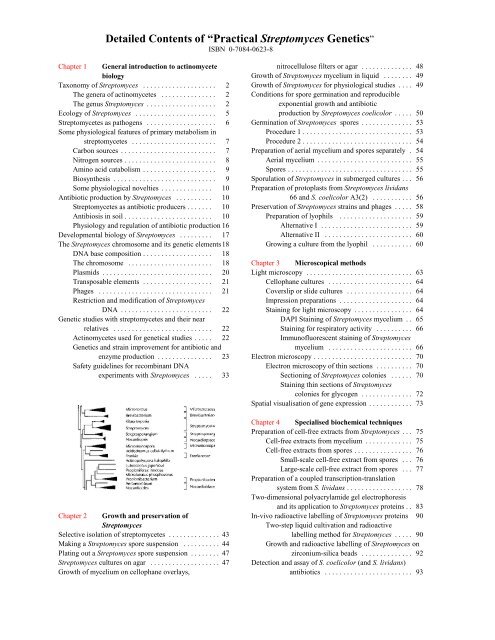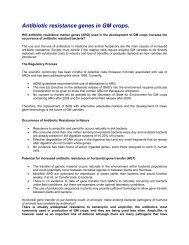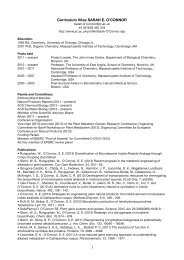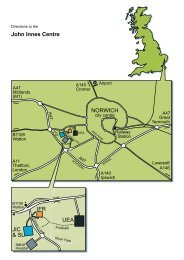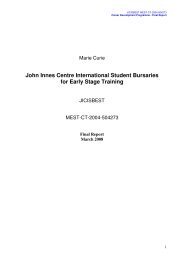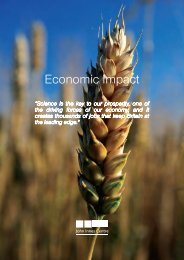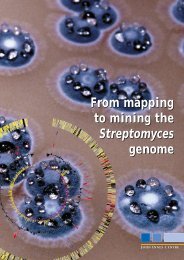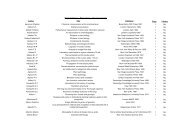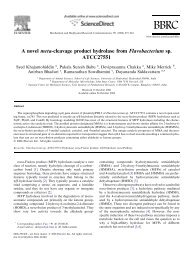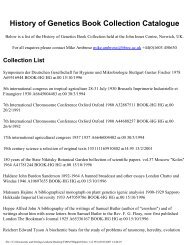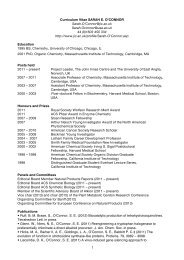Detailed Contents of "Practical Streptomyces Genetics" - John Innes ...
Detailed Contents of "Practical Streptomyces Genetics" - John Innes ...
Detailed Contents of "Practical Streptomyces Genetics" - John Innes ...
You also want an ePaper? Increase the reach of your titles
YUMPU automatically turns print PDFs into web optimized ePapers that Google loves.
<strong>Detailed</strong> <strong>Contents</strong> <strong>of</strong> “<strong>Practical</strong> <strong>Streptomyces</strong> Genetics”<br />
ISBN 0-7084-0623-8<br />
Chapter 1 General introduction to actinomycete<br />
biology<br />
Taxonomy <strong>of</strong> <strong>Streptomyces</strong> .................... 2<br />
The genera <strong>of</strong> actinomycetes ............... 2<br />
The genus <strong>Streptomyces</strong> ................... 2<br />
Ecology <strong>of</strong> <strong>Streptomyces</strong> ...................... 5<br />
Streptomycetes as pathogens ................... 6<br />
Some physiological features <strong>of</strong> primary metabolism in<br />
streptomycetes ....................... 7<br />
Carbon sources .......................... 7<br />
Nitrogen sources......................... 8<br />
Amino acid catabolism.................... 9<br />
Biosynthesis ............................ 9<br />
Some physiological novelties .............. 10<br />
Antibiotic production by <strong>Streptomyces</strong> .......... 10<br />
Streptomycetes as antibiotic producers....... 10<br />
Antibiosis in soil........................ 10<br />
Physiology and regulation <strong>of</strong> antibiotic production 16<br />
Developmental biology <strong>of</strong> <strong>Streptomyces</strong> ......... 17<br />
The <strong>Streptomyces</strong> chromosome and its genetic elements 18<br />
DNA base composition ................... 18<br />
The chromosome ....................... 18<br />
Plasmids .............................. 20<br />
Transposable elements ................... 21<br />
Phages ............................... 21<br />
Restriction and modification <strong>of</strong> <strong>Streptomyces</strong><br />
DNA ......................... 22<br />
Genetic studies with streptomycetes and their near<br />
relatives ........................... 22<br />
Actinomycetes used for genetical studies ..... 22<br />
Genetics and strain improvement for antibiotic and<br />
enzyme production ............... 23<br />
Safety guidelines for recombinant DNA<br />
experiments with <strong>Streptomyces</strong> ..... 33<br />
Chapter 2 Growth and preservation <strong>of</strong><br />
<strong>Streptomyces</strong><br />
Selective isolation <strong>of</strong> streptomycetes .............. 43<br />
Making a <strong>Streptomyces</strong> spore suspension .......... 44<br />
Plating out a <strong>Streptomyces</strong> spore suspension ........ 47<br />
<strong>Streptomyces</strong> cultures on agar ................... 47<br />
Growth <strong>of</strong> mycelium on cellophane overlays,<br />
nitrocellulose filters or agar .............. 48<br />
Growth <strong>of</strong> <strong>Streptomyces</strong> mycelium in liquid ........ 49<br />
Growth <strong>of</strong> <strong>Streptomyces</strong> for physiological studies .... 49<br />
Conditions for spore germination and reproducible<br />
exponential growth and antibiotic<br />
production by <strong>Streptomyces</strong> coelicolor ..... 50<br />
Germination <strong>of</strong> <strong>Streptomyces</strong> spores .............. 53<br />
Procedure 1.............................. 53<br />
Procedure 2.............................. 54<br />
Preparation <strong>of</strong> aerial mycelium and spores separately . 54<br />
Aerial mycelium .......................... 55<br />
Spores.................................. 55<br />
Sporulation <strong>of</strong> <strong>Streptomyces</strong> in submerged cultures . . . 56<br />
Preparation <strong>of</strong> protoplasts from <strong>Streptomyces</strong> lividans<br />
66 and S. coelicolor A3(2) ........... 56<br />
Preservation <strong>of</strong> <strong>Streptomyces</strong> strains and phages ..... 58<br />
Preparation <strong>of</strong> lyophils .................... 59<br />
Alternative I ......................... 59<br />
Alternative II ........................ 60<br />
Growing a culture from the lyophil ........... 60<br />
Chapter 3 Microscopical methods<br />
Light microscopy ............................. 63<br />
Cellophane cultures ....................... 64<br />
Coverslip or slide cultures .................. 64<br />
Impression preparations .................... 64<br />
Staining for light microscopy ................ 64<br />
DAPI Staining <strong>of</strong> <strong>Streptomyces</strong> mycelium . . 65<br />
Staining for respiratory activity .......... 66<br />
Immun<strong>of</strong>luorescent staining <strong>of</strong> <strong>Streptomyces</strong><br />
mycelium ....................... 66<br />
Electron microscopy........................... 70<br />
Electron microscopy <strong>of</strong> thin sections .......... 70<br />
Sectioning <strong>of</strong> <strong>Streptomyces</strong> colonies ...... 70<br />
Staining thin sections <strong>of</strong> <strong>Streptomyces</strong><br />
colonies for glycogen .............. 72<br />
Spatial visualisation <strong>of</strong> gene expression............ 73<br />
Chapter 4 Specialised biochemical techniques<br />
Preparation <strong>of</strong> cell-free extracts from <strong>Streptomyces</strong> ... 75<br />
Cell-free extracts from mycelium ............. 75<br />
Cell-free extracts from spores................ 76<br />
Small-scale cell-free extract from spores . . . 76<br />
Large-scale cell-free extract from spores . . . 77<br />
Preparation <strong>of</strong> a coupled transcription-translation<br />
system from S. lividans .................. 78<br />
Two-dimensional polyacrylamide gel electrophoresis<br />
and its application to <strong>Streptomyces</strong> proteins . . 83<br />
In-vivo radioactive labelling <strong>of</strong> <strong>Streptomyces</strong> proteins 90<br />
Two-step liquid cultivation and radioactive<br />
labelling method for <strong>Streptomyces</strong> ..... 90<br />
Growth and radioactive labelling <strong>of</strong> <strong>Streptomyces</strong> on<br />
zirconium-silica beads .............. 92<br />
Detection and assay <strong>of</strong> S. coelicolor (and S. lividans)<br />
antibiotics ........................ 93
The S. coelicolor antibiotics................. 93<br />
Actinorhodin ......................... 93<br />
Undecylprodigiosin ................... 95<br />
CDA ............................... 95<br />
Methylenomycin...................... 95<br />
S. lividans as an antibiotic producer........... 95<br />
Secondary metabolite production in S. lividans<br />
transformants .................. 95<br />
Chapter 5 Mutagenesis <strong>of</strong> <strong>Streptomyces</strong> by<br />
irradiation or chemicals<br />
General remarks about mutagenesis ............... 99<br />
The optimal amount <strong>of</strong> mutagenesis ........... 99<br />
Expression <strong>of</strong> mutations ................... 100<br />
Spores or mycelium? ..................... 101<br />
Choice <strong>of</strong> mutagen ....................... 101<br />
Precautions ............................. 101<br />
Mutagenesis <strong>of</strong> <strong>Streptomyces</strong> spores by ultraviolet<br />
light (UV) ....................... 102<br />
Mutagenesis <strong>of</strong> <strong>Streptomyces</strong> spores by N-methyl-Nnitro-N-nitrosoguanidine<br />
(NTG) ...... 103<br />
Isolation <strong>of</strong> specific classes <strong>of</strong> mutant ............ 104<br />
Resistant mutants ........................ 104<br />
Mutants that have to be isolated by screening . . 104<br />
Auxotrophs ......................... 104<br />
Other classes <strong>of</strong> mutants screened by replica<br />
plating......................... 106<br />
Mutants recognised by visual examination . 106<br />
Chapter 6 Transposon mutagenesis in <strong>Streptomyces</strong><br />
General points about transposon mutagenesis ...... 109<br />
Discovery <strong>of</strong> <strong>Streptomyces</strong> transposable elements 110<br />
<strong>Streptomyces</strong> transposons suitable for<br />
mutagenesis <strong>of</strong> <strong>Streptomyces</strong> ........ 110<br />
Use <strong>of</strong> heterologous transposons for<br />
mutagenising <strong>Streptomyces</strong> genes..... 110<br />
Transposon delivery vectors for <strong>Streptomyces</strong> . . 110<br />
Isolation <strong>of</strong> independent mutant strains ....... 111<br />
Cloning transposon-tagged <strong>Streptomyces</strong><br />
DNA in E. coli ................... 111<br />
Tn4556 from S. fradiae ....................... 111<br />
A. Transposition <strong>of</strong> Tn4560 from pUC1169 to a<br />
chromosomal location.............. 112<br />
B. Protocol for inserting Tn4560 into<br />
S. coelicolor NF strains ............ 113<br />
C. Tn4560 mutagenesis <strong>of</strong> SCP2* plasmids in<br />
S. lividans ....................... 114<br />
D. Tn4560 mutagenesis <strong>of</strong> pock-forming SCP2*<br />
in S. coelicolor ................... 115<br />
IS493 from S. lividans 66 ...................... 117<br />
E. Sectoring method for delivering IS493<br />
derivatives using temperature-sensitive<br />
plasmids ........................ 117<br />
IS6100 from Mycobacterium fortuitum ........... 119<br />
F. Transposon mutagenesis <strong>of</strong> S. lividans using<br />
pSIT151 ........................ 119<br />
Tn5493 derived from Tn5 ..................... 121<br />
G. Mutagenising S. lividans using pJOE2577 . . 121<br />
H. Alternative method for isolating S. lividans<br />
with random insertions <strong>of</strong> Tn5493 .... 122<br />
Chapter 7 In vivo genetic analysis by conjugation<br />
and protoplast fusion<br />
The modes <strong>of</strong> gene exchange in <strong>Streptomyces</strong> ...... 125<br />
Mating ................................ 125<br />
Protoplast fusion......................... 128<br />
Transduction............................ 128<br />
Chromosomal recombination by transformation 128<br />
Electroporation .......................... 130<br />
The practicalities <strong>of</strong> making crosses .............. 130<br />
Quantitative analysis <strong>of</strong> crosses ................. 136<br />
Recombination frequency.................. 136<br />
Frequency <strong>of</strong> plasmid transfer .............. 137<br />
Linkage mapping ........................ 137<br />
Establishing a genetic map by the "four-on-four"<br />
procedure ........................... 141<br />
The "classical" way <strong>of</strong> analysing the results <strong>of</strong> a<br />
"four-on-four" cross .................. 144<br />
Analysing the results <strong>of</strong> a "four-on-four" cross by<br />
minimizing multiple crossovers ......... 147<br />
Mapping a new marker by a single selection ....... 147<br />
Plate-crosses................................ 152<br />
Detection <strong>of</strong> conjugative plasmids by "pock"<br />
formation by transconjugants ............ 153<br />
Protoplast fusion ............................ 156<br />
Fusion <strong>of</strong> protoplasts <strong>of</strong> S. coelicolor<br />
or S. lividans ........................ 157<br />
Genetic analysis by protoplast fusion ......... 158<br />
Chapter 8 Preparation and analysis <strong>of</strong> genomic and<br />
plasmid DNA<br />
Isolation <strong>of</strong> genomic DNA ..................... 162<br />
Discussion <strong>of</strong> individual steps .............. 162<br />
A. Kirby mix procedure for the isolation <strong>of</strong><br />
genomic DNA ...................... 168<br />
B. Salting out procedure for the isolation <strong>of</strong><br />
genomic DNA....................... 169<br />
C. CTAB procedure for the isolation <strong>of</strong> genomic<br />
DNA .............................. 170<br />
Isolation <strong>of</strong> CCC plasmid DNA ................. 171<br />
Discussion <strong>of</strong> individual steps .............. 172<br />
A. Plasmid isolation by neutral lysis ......... 177<br />
B. Standard CsCl-ethidium bromide gradient<br />
centrifugation ....................... 178<br />
C. CsCl density gradient for removing<br />
polysaccharides from DNA ............. 182<br />
D. Plasmid isolation by alkaline lysis and<br />
potassium acetate precipitation .......... 184<br />
E. Plasmid isolation by alkaline lysis and phenol
precipitation ..................... 187<br />
F. Plasmid purification using QIAGEN anion<br />
exchange column chromatography .... 189<br />
G. Plasmid isolation by the boiling method .... 190<br />
H. Alkaline denaturation <strong>of</strong> partially purified<br />
DNA samples .................... 191<br />
I. Purification <strong>of</strong> samples using ethidium<br />
bromide......................... 192<br />
J. Acid phenol (pH4) extraction ............ 193<br />
K. “Jurassic preps” plasmid purification using<br />
guanidine thiocyanate.............. 194<br />
Standard agarose gel electrophoresis ............. 195<br />
Pulsed-field gel electrophoresis ................. 198<br />
General considerations .................... 198<br />
Standard procedure for preparing <strong>Streptomyces</strong><br />
chromosomal DNA for PFGE........ 199<br />
Phenol wash procedure for preparation <strong>of</strong><br />
actinomycete DNA for PFGE ........ 201<br />
Digestion <strong>of</strong> DNA with restriction endonucleases<br />
in agarose blocks for PFGE ......... 202<br />
Loading gels ............................ 203<br />
Running conditions for PFGE .............. 204<br />
Removal <strong>of</strong> small DNA fragments ........... 205<br />
Solutions .................................. 205<br />
Ammonium acetate ....................... 205<br />
EDTA pH8 ............................. 206<br />
Lithium chloride......................... 206<br />
Sodium chloride ........................ 206<br />
Sodium hydroxide ....................... 207<br />
Potassium acetate and sodium acetate, 3M ..... 207<br />
Tris-HCl buffer.......................... 208<br />
Chapter 9 General considerations about gene<br />
cloning in <strong>Streptomyces</strong><br />
Features <strong>of</strong> <strong>Streptomyces</strong> genes ................. 212<br />
Restriction-modification and other host factors ..... 213<br />
Preparation <strong>of</strong> vector and target DNA ............ 214<br />
How many clones are required for making a<br />
representative gene library? ............. 214<br />
Choice and use <strong>of</strong> restriction endonucleases<br />
for making gene libraries ............... 214<br />
Choice <strong>of</strong> cloning vector ...................... 215<br />
Vector host-range ........................ 215<br />
Size <strong>of</strong> the target DNA .................... 216<br />
Integrating vectors ....................... 216<br />
Low copy number plasmid vectors........... 217<br />
High copy number plasmid vectors .......... 217<br />
Plasmid versus phage vectors ............... 217<br />
Positive selection vectors .................. 218<br />
E. coli vectors containing <strong>Streptomyces</strong> selection<br />
markers ......................... 218<br />
Using bifunctional vectors that replicate in E. coli<br />
and <strong>Streptomyces</strong> ................. 219<br />
Selective markers ............................ 219<br />
Antibiotic resistance ...................... 219<br />
Counterselectable markers ................. 220<br />
Ligation conditions........................... 220<br />
Transformation .............................. 221<br />
Finding the desired clone ...................... 221<br />
Sib-Selection ........................... 222<br />
Antibiotic biosynthetic genes ............... 224<br />
Confirmation <strong>of</strong> clones........................ 224<br />
Does the phenotype depend on the cloned DNA? 224<br />
Is the cloned DNA rearranged? ............. 225<br />
Is the promoter for a cloned gene present on the<br />
cloned DNA? .................... 225<br />
What if the desired gene cannot be cloned? ........ 226<br />
Assessing the quality <strong>of</strong> <strong>Streptomyces</strong> gene libraries . 226<br />
Storing gene libraries ......................... 226<br />
Chapter 10 Introduction <strong>of</strong> DNA into <strong>Streptomyces</strong><br />
Methods available ........................... 230<br />
Restriction barriers ........................... 230<br />
Use <strong>of</strong> single-stranded DNA.................... 230<br />
Transformation and transfection in <strong>Streptomyces</strong> .... 231<br />
Polyethylene glycol (PEG) ................. 231<br />
Transformation and transfection frequencies . . . 232<br />
PEG-assisted transformation <strong>of</strong> <strong>Streptomyces</strong><br />
protoplasts with plasmid DNA ........... 232<br />
Standard procedure....................... 232<br />
Rapid small-scale procedure................ 234<br />
Use <strong>of</strong> denatured DNA for protoplast<br />
transformation.................... 235<br />
Spot-transformation ...................... 236<br />
Cosmid transformation .................... 236<br />
Electroporation <strong>of</strong> mycelium ................... 237<br />
Recognition, selection and screening <strong>of</strong> <strong>Streptomyces</strong><br />
transformants..................... 239<br />
Lethal zygosis reaction (pocks) ............. 239<br />
Fertility ................................ 239<br />
Resistance markers ....................... 239<br />
Selection <strong>of</strong> antibiotic-resistant transformants by<br />
overlaying or flooding ................ 240<br />
S<strong>of</strong>t agar overlays .................... 240<br />
Flooding ........................... 240<br />
Detection <strong>of</strong> melanin-producing colonies ...... 240<br />
Screening for plasmid DNA ................ 242<br />
Colony hybridisation ..................... 242<br />
Using nitrocellulose filters ............. 242<br />
Using Whatman 541 paper ............. 243<br />
Preparation <strong>of</strong> colony replicas ...... 244<br />
Hybridisation ................... 245<br />
5 end labelling <strong>of</strong> oligonucleotide<br />
probes ............. 246<br />
Using Whatman 540 paper ............. 247<br />
Use <strong>of</strong> the Polymerase Chain Reaction (PCR) to<br />
identify transformants.............. 248<br />
Conjugation from E. coli ...................... 249
Chapter 11 Plasmids and their use for gene cloning<br />
General properties <strong>of</strong> <strong>Streptomyces</strong> plasmids and<br />
their use for gene cloning ............... 253<br />
Wild-type plasmids that have been used extensively<br />
to construct cloning vectors.......... 256<br />
pIJ101................................. 256<br />
pJV1 .................................. 258<br />
pSG5.................................. 259<br />
SCP2*................................. 260<br />
Higher copy number derivatives <strong>of</strong> SCP2* . 263<br />
SCP2* vectors as delivery systems for gene<br />
disruptions ..................... 264<br />
SLP1 and pSAM2........................ 265<br />
Other integrating vectors .................. 265<br />
List <strong>of</strong> special purpose vectors .................. 267<br />
Bifunctional E. coli-<strong>Streptomyces</strong> plasmids .... 267<br />
oriT (RK2) vectors for conjugation between E. coli<br />
and <strong>Streptomyces</strong> ................. 267<br />
cosmid vectors......................... 267<br />
Expression vectors ....................... 268<br />
Vectors with promoterless reporter genes ..... 268<br />
Positive selection vectors .................. 268<br />
Integrating vectors ....................... 268<br />
Unstable and temperature-sensitive plasmids useful<br />
for gene replacement and<br />
transposon delivery................ 268<br />
Vectors without the tsr gene................ 268<br />
Vectors with resistance markers other than the<br />
common ones .................... 268<br />
Vectors with blue/white selection (lacZ )<br />
in E. coli ........................ 269<br />
Chapter 12 <strong>Streptomyces</strong> phages<br />
The relevance <strong>of</strong> phages to <strong>Streptomyces</strong> genetics . . . 271<br />
Occurrence, isolation and storage <strong>of</strong> <strong>Streptomyces</strong><br />
phages .......................... 272<br />
Lytic and temperate phages ................ 272<br />
Phages from soil ......................... 272<br />
Phages from lysogens ..................... 272<br />
Phages as industrial contaminants ........... 273<br />
<strong>Streptomyces</strong> phage genetics ................... 273<br />
In vivo physiological and genetic studies...... 273<br />
Deletion mutants and DNA packaging limitation 273<br />
Phage DNA ............................ 273<br />
Uses <strong>of</strong> wild-type phages in the study <strong>of</strong> their hosts . 274<br />
Transduction............................ 274<br />
Localised mutagenesis using generalised<br />
transduction ..................... 274<br />
Restriction-modification systems ............ 275<br />
Storage <strong>of</strong> <strong>Streptomyces</strong> phages ................. 276<br />
Plaque assay <strong>of</strong> <strong>Streptomyces</strong> phages............. 277<br />
Single-plaque isolation <strong>of</strong> <strong>Streptomyces</strong> phages..... 278<br />
Preparation <strong>of</strong> high-titre <strong>Streptomyces</strong> phage stocks . 278<br />
Isolation <strong>of</strong> new <strong>Streptomyces</strong> phages ............ 279<br />
Isolation procedure I (direct method) ......... 280<br />
Isolation procedure II (specific enrichment).... 281<br />
Selection <strong>of</strong> potential transducing phages by<br />
pyrophosphate resistance .................. 281<br />
Generalised transduction <strong>of</strong> S. venezuelae using SV1<br />
phage .......................... 282<br />
Large-scale preparation <strong>of</strong> <strong>Streptomyces</strong> phage DNA 282<br />
Small-scale preparation <strong>of</strong> <strong>Streptomyces</strong> phage DNA 285<br />
Chapter 13 Cloning with phage vectors<br />
General features <strong>of</strong> C31 and its vector derivatives . 290<br />
Shotgun cloning with C31 vectors.......... 290<br />
Choice <strong>of</strong> C31 vectors for mutational cloning . 291<br />
Choice <strong>of</strong> C31 vectors for screening by<br />
complementation <strong>of</strong> mutants ........ 291<br />
or acquisition <strong>of</strong> new capabilities ............ 292<br />
Ligation conditions....................... 294<br />
Maximising and estimating insert frequency . . . 294<br />
Construction and stability <strong>of</strong> lysogens ........ 294<br />
Homogenotisation ....................... 295<br />
Application <strong>of</strong> C31 to gene fusions ......... 296<br />
General features <strong>of</strong> the C31::xylE vectors ........ 296<br />
KC862: a xylE-containing C31 derivative<br />
that gives yellow plaques<br />
only when carrying inserts with active promoters 296<br />
A single copy number promoter-probe vector,<br />
KC859 ......................... 298<br />
Vectors for in situ fusions <strong>of</strong> xylE to chromo<br />
somally located transcription units . . . 298<br />
Other phage-based cloning systems .............. 299<br />
Prophage transformation with phage SAt-1 <strong>of</strong><br />
S. azureus ....................... 299<br />
Phage-mediated transduction <strong>of</strong> plasmids ..... 299<br />
Vectors based on other <strong>Streptomyces</strong> phages . . . 300<br />
Use <strong>of</strong> integration functions <strong>of</strong> <strong>Streptomyces</strong><br />
phages.......................... 300<br />
Transfection ................................ 301<br />
Transfer <strong>of</strong> <strong>Streptomyces</strong> phage DNA onto<br />
nitrocellulose filters for “plaque hybridisation” . 303<br />
Preparation <strong>of</strong> C31 lysogens .................. 303<br />
Procedure A ............................ 304<br />
Procedure B ............................ 305<br />
“Low-tech” method for detecting C31 derivatives<br />
containing resistance genes .......... 306<br />
Use <strong>of</strong> glkA counterselection to select deletions from,<br />
or loss <strong>of</strong>, C31 prophages .......... 307
Chapter 14 Gene disruption and gene replacement<br />
Creating null mutants ......................... 311<br />
Method (a). Insertional inactivation via a single<br />
crossover........................ 312<br />
Method (b). Insertional inactivation via double<br />
crossing over..................... 313<br />
Method (c). Insertional inactivation using an inframe<br />
deletion.................... 314<br />
Other factors affecting the choice <strong>of</strong> approach...... 316<br />
Polar effects ............................ 316<br />
The size <strong>of</strong> intervals used .................. 316<br />
Mutation stability ........................ 316<br />
Method <strong>of</strong> delivery ........................... 316<br />
Non-replicating E. coli plasmids ............ 317<br />
Temperature-sensitive replicons ............. 318<br />
Phage vectors ........................... 318<br />
Unstable replicons ....................... 319<br />
Dealing with essential genes.................... 319<br />
Introduction <strong>of</strong> point mutations and other subtle<br />
changes ......................... 320<br />
Counterselection <strong>of</strong> the delivery vector ........... 320<br />
"Heterologous" disruptions and replacements ...... 323<br />
Choice <strong>of</strong> resistance markers ................... 323<br />
Selecting for single crossover intermediates during<br />
gene replacement .................. 324<br />
A practical example <strong>of</strong> gene disruption ........... 324<br />
Homogenotisation ........................... 328<br />
Problems arising from unintended<br />
homogenotisation events ........... 329<br />
Cloning mutant alleles by homogenotisation . . . 330<br />
Gene replacements involving whole gene clusters . . . 332<br />
Mutational analysis <strong>of</strong> transcription units ......... 334<br />
Chapter 15 Reporter systems<br />
Introduction ................................ 339<br />
The problems with lacZ ....................... 340<br />
Choice <strong>of</strong> vector: plasmid, phage and transposon<br />
systems ......................... 341<br />
Antibiotic resistance genes as reporters: neo and cat . 342<br />
The tyrosinase-encoding operon <strong>of</strong> S. glaucescens<br />
as a reporter system ................ 342<br />
The whiE (spore pigment) major operon as a reporter<br />
system .......................... 343<br />
The catechol 2,3-dioxygenase determinant, xylE, a<br />
readily quantified reporter gene for<br />
<strong>Streptomyces</strong> ............................ 343<br />
Detection <strong>of</strong> xylE expression in situ in colonies . 344<br />
Detection <strong>of</strong> xylE expression in C31 plaques . 344<br />
Assay <strong>of</strong> catechol 2,3-dioxygenase in cell-free<br />
extracts ......................... 345<br />
Use <strong>of</strong> the Vibrio harveyi luxAB genes as a reporter<br />
system .......................... 346<br />
Reporter systems based on EGFP................ 347<br />
A reporter gene encoding a thermostable malate<br />
dehydrogenase.................... 348<br />
Assay <strong>of</strong> thermostable malate dehydrogenase in<br />
cell-free extracts .................. 348<br />
The ampC ( -lactamase) gene as a reporter ........ 349<br />
The lac (secreted -galactosidase) gene <strong>of</strong> S. lividans<br />
as a reporter for transcription and<br />
secretion ........................ 349<br />
The redD gene <strong>of</strong> S. coelicolor as an easily scorable<br />
reporter <strong>of</strong> transcription in S. coelicolor<br />
and S. lividans .................... 350<br />
Chapter 16 RNA methods<br />
General precautions when working with RNA ...... 354<br />
Harvesting <strong>Streptomyces</strong> cultures for RNA isolation . 354<br />
Isolation <strong>of</strong> RNA ............................ 354<br />
Isolation <strong>of</strong> RNA using modified Kirby mix,<br />
phenol/chlor<strong>of</strong>orm extraction and<br />
DNase I treatment ................. 355<br />
Isolation <strong>of</strong> RNA using CsCl gradients ........ 357<br />
Isolation <strong>of</strong> RNA using SDS and hot phenol . . . 359<br />
Storage <strong>of</strong> RNA ............................. 360<br />
Assessing the quantity and quality <strong>of</strong> RNA<br />
preparations ...................... 360<br />
Spectrophotometry ....................... 360<br />
Agarose gel electrophoresis ................ 361<br />
High resolution S1 nuclease mapping ............. 363<br />
General strategies for making probes for high<br />
resolution S1 nuclease mapping ...... 363<br />
Notes <strong>of</strong> caution in probe construction ........ 366<br />
Specific activity <strong>of</strong> the probe ............... 366<br />
How much probe to add to each hybridisation<br />
reaction ......................... 367<br />
High resolution S1 nuclease mapping <strong>of</strong> the<br />
3 ends <strong>of</strong> transcripts ............... 367<br />
Hybridisation solution .................... 368<br />
The practicalities <strong>of</strong> high resolution S1 nuclease<br />
mapping ........................ 369<br />
Controls ............................... 370<br />
Generating sequencing ladders for high<br />
resolution S1 nuclease mapping ...... 371<br />
Interpretation <strong>of</strong> results .................... 371<br />
Low resolution S1 nuclease mapping ............. 372<br />
Primer extension mapping ..................... 373<br />
Northern blotting ............................ 374<br />
In vitro transcription .......................... 374<br />
<strong>Streptomyces</strong> RNA polymerase purification ........ 377<br />
Standard purification <strong>of</strong> <strong>Streptomyces</strong> RNA<br />
polymerase ...................... 377<br />
Purification <strong>of</strong> histidine-tagged RNA<br />
polymerase ...................... 382
Preparation <strong>of</strong> DNA-cellulose .................. 383<br />
Chapter 17 Production and secretion <strong>of</strong> proteins by<br />
<strong>Streptomyces</strong><br />
Transcription initiation ........................ 385<br />
Translation initiation ......................... 386<br />
Signal peptides .............................. 387<br />
Codon usage ................................ 387<br />
Regulated expression systems .................. 388<br />
Culture conditions ........................... 388<br />
Levels <strong>of</strong> expression.......................... 388<br />
A selection <strong>of</strong> plasmids suitable for intracellular<br />
expression ....................... 389<br />
Plasmids suitable for secretion .................. 390<br />
Optimising expression <strong>of</strong> <strong>Streptomyces</strong> genes in<br />
E. coli .......................... 391<br />
Changing the codon usage at the 5 end <strong>of</strong> a<br />
coding region .................... 391<br />
E. coli vectors that have been used to overexpress<br />
streptomycete genes......... 391<br />
Chapter 18 Analysing <strong>Streptomyces</strong> DNA<br />
DNA sequencing ............................ 393<br />
Alternative and additional Maxam and Gilbert<br />
base-specific reactions for sequencing<br />
end-labelled DNA................. 394<br />
Sequence analysis............................ 395<br />
Identifying protein coding regions ........... 395<br />
FRAME analysis..................... 395<br />
Codon preference .................... 397<br />
Hidden Markov model ................ 398<br />
Codon usage tables ....................... 398<br />
Accessing <strong>Streptomyces</strong> (actinomycete)<br />
sequences in the databases .......... 398<br />
Design <strong>of</strong> oligonucleotides for use as probes and<br />
PCR primers ......................... 402<br />
PCR conditions ............................. 402<br />
Chapter 19 Media, buffers and suppliers<br />
Agar Media................................. 406<br />
Minimal medium (MM) ................... 406<br />
Complete medium (CM)................... 407<br />
Hickey-Tresner agar (HT agar).............. 407<br />
R2 Medium............................. 408<br />
R2YE Medium .......................... 408<br />
R5 Medium............................. 409<br />
Mannitol soya flour medium (MS)........... 409<br />
Supplemented minimal medium, solid (SMMS) 410<br />
MMT ................................. 410<br />
Difco nutrient agar (DNA) ................. 411<br />
Oxoid nutrient agar (ONA)................. 411<br />
S<strong>of</strong>t nutrient agar (SNA) .................. 411<br />
L agar ................................. 411<br />
Liquid media ............................... 412<br />
Yeast extract-malt extract medium (YEME) . . . 412<br />
Tryptone soya broth (TSB)................. 412<br />
Difco nutrient broth (DNB) ................ 412<br />
L broth (LB) ............................ 412<br />
Supplemented liquid minimal medium (SMM) . 413<br />
Minimal liquid medium (NMMP) ........... 413<br />
Labelling medium for <strong>Streptomyces</strong> .......... 414<br />
2 X YT medium ......................... 414<br />
Growth factor supplements ..................... 415<br />
Buffers .................................... 415<br />
P (protoplast) Buffer...................... 415<br />
T (transformation) buffer .................. 416<br />
L (lysis) buffer .......................... 416<br />
TE Buffer .............................. 417<br />
SM Buffer.............................. 417<br />
120 × SSC ............................. 417<br />
Addresses <strong>of</strong> suppliers ........................ 418<br />
Chapter 20 Genome maps and genetically marked<br />
strains<br />
S. coelicolor A3(2) ........................... 423<br />
Genetic/physical map ..................... 423<br />
Genetically marked strains ................. 423<br />
Genome sequencing project ................ 424<br />
S. lividans 66 ............................... 425<br />
Genetic/physical map ..................... 425<br />
Genetically marked strains ................. 425<br />
Genetic differences between S. coelicolor A3(2)<br />
and S. lividans 66 ................. 426<br />
S. griseus .................................. 430<br />
S. amb<strong>of</strong>aciens .............................. 433<br />
S. rimosus .................................. 433<br />
Plasmids SCP1 and SLP2...................... 433<br />
Chapter 21 Maps <strong>of</strong> DNA fragments<br />
Conventions used for the restriction maps ......... 440<br />
List <strong>of</strong> restriction endonucleases, recognition<br />
sites and isoschizomers (Table) ...... 441<br />
Lists <strong>of</strong> genes ............................... 442<br />
Alphabetical list <strong>of</strong> resistance and indicator genes,<br />
and other DNA fragments (Table) .... 442<br />
List <strong>of</strong> genes grouped according to function .... 446<br />
Resistance genes ..................... 446<br />
Counterselectable markers ............. 449<br />
Indicator genes ...................... 449<br />
Other DNA fragments ................. 449<br />
Resistance genes grouped according to<br />
antibiotic class ................... 450<br />
Aminoglycosides .................... 450<br />
Bialaphos, phosphinothricin ............ 450<br />
Bleomycin, phleomycin ............... 450<br />
Chloramphenicol ..................... 450
Gyrase inhibitors, novobiocin, cipr<strong>of</strong>loxacin 450<br />
Hygromycin ........................ 450<br />
Macrotetrolides, nonactin, tetranactin ..... 450<br />
MLS (macrolide, lincosamide and<br />
streptogramin B) resistance ...... 451<br />
Puromycin .......................... 451<br />
Spectinomycin, streptomycin ........... 451<br />
Streptothricins ....................... 451<br />
Tetracyclines ........................ 451<br />
Thiostrepton and analogues ............ 451<br />
Viomycin, capreomycin B ............. 451<br />
Other resistances ..................... 451<br />
Antibiotics, antimetabolites, and suppliers (Table) . . . 452<br />
Maps <strong>of</strong> DNA fragments ...................... 456<br />
Resistance genes ......................... 456<br />
Counterselectable markers ................. 493<br />
Indicator genes .......................... 495<br />
Other DNA fragments .................... 502<br />
Integrating plasmids derived from C31 and<br />
phage VWB (Table) ...................... 514<br />
Plasmid maps grouped according to the <strong>Streptomyces</strong><br />
replicon (Table) ............... 514<br />
E. coli plasmids (Table) ................... 517<br />
Transposable elements (Table) .............. 518<br />
Restriction maps............................. 519<br />
Phage C31 and its derivatives ............. 519<br />
Integrating plasmids derived from C31 and<br />
phage VWB .................... 530<br />
Plasmid maps grouped according to the<br />
<strong>Streptomyces</strong> replicon............. 533<br />
pIJ101 derivatives .................... 533<br />
pRES1 derivatives ................... 545<br />
pJV1 derivatives ..................... 546<br />
pSG5 derivatives .................... 548<br />
SCP2* derivatives.................... 553<br />
pSAM2 and SLP1 derivatives .......... 563<br />
E. coli plasmids ......................... 564<br />
Transposable elements .................... 573<br />
IS117 derivatives .................... 573<br />
IS493 derivatives .................... 575<br />
Tn4556 derivatives ................... 578<br />
Chapter 22 Maps <strong>of</strong> plasmids, transposons and<br />
phage genomes<br />
Conventions used for the restriction maps ......... 512<br />
Lists <strong>of</strong> all restriction maps .................... 512<br />
Phage C31 and its derivatives (Table) ....... 513<br />
Tn5 derivative....................... 581<br />
Index with 3000 entries ................585-613
<strong>Practical</strong> <strong>Streptomyces</strong> Genetics<br />
Order form<br />
Please print this form, fill it in and mail it, with payment made out to the <strong>John</strong> <strong>Innes</strong> Centre<br />
Ltd, to:<br />
D.A. Hopwood (<strong>Streptomyces</strong> Manual)<br />
<strong>John</strong> <strong>Innes</strong> Centre<br />
Norwich<br />
NR4 7UH<br />
England<br />
E-mail david.hopwood@bbsrc.ac.uk, in case <strong>of</strong> queries)<br />
Price per copy £ 60.-- plus postage and packing*<br />
Postage and packing charges:<br />
UK and Europe: £ 7.00 per book<br />
Rest <strong>of</strong> the world: £ 12.00 per book<br />
I should like to order . . . . . . . copies <strong>of</strong> the book (publication date July 2000)<br />
Payment must be made in pounds sterling only, to the <strong>John</strong> <strong>Innes</strong> Centre Ltd by one <strong>of</strong> the<br />
following methods.<br />
• I enclose a CHEQUE for £ . . . . . . . . drawn against a UK bank<br />
• I enclose an INTERNATIONAL MONEY ORDER for £ . . . . . . . .payable through a UK<br />
designated Bank<br />
• I enclose a BANKER's DRAFT for £ . . . . . . . .payable through a UK clearing bank<br />
Delivery address (this is your mailing label: please use typewriter or block capitals)<br />
Name:<br />
Address:<br />
Email (optional):


